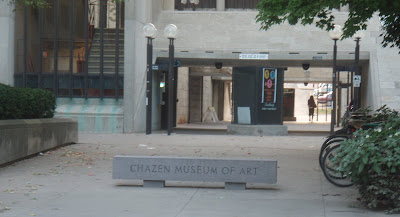Whenever I'm leaving a city that I've lived in, I make a point of wandering around with my camera. This weekend I'm leaving New York for the foreseeable future and entering phase one of my two-part move to Madison, Wisconsin, where I'll be starting a graduate degree in art history. Last weekend I couldn't exactly wander around all five boroughs, but in between sorting and packing I did manage to take one last walk around the neighborhood.


The Upper West Side has two basic streetscapes. On the left is one of the many charming tree lined blocks, still home to brownstones and other townhouses. On the right is one of the broad vista created by wide streets and heavy apartment buildings, each at an identical height, each with an identical doorman. There's no question which I'd rather live on.


I've come to think of my neighborhood as a stretch of Riverside Park bracketed by two memorials: the Soldiers and Sailors Monument at around 90th Street and Grant's Tomb at around 125th. The Soldiers and Sailors Monument, shown above left, is a tholos (a round temple form first used in ancient Greece) with Corinthian columns and an elaborate entablature and base. It is approached from the south through a lovely avenue of trees. Just below it on the Greenway section of the park is this lovely garden (above right), presided over by volunteer gardeners. Grant's tomb, below right, stands next to Riverside Church, below left, and they form an impressive sight peaking up from the trees along the river. At this point Grant's tomb is probably most famous for the question "who's buried at Grant's Tomb?" which only the most unthinking are supposed to answer wrong. I always thought that was because the answer is obviously in the title, Grant is buried is Grant's tomb, but it turns out that no one is. Grant is laid to rest there, but his body is above ground; he is entombed rather than buried.




One of my favorite things about summer is seeing and hearing little kids enjoy the sprinkler fountains around the city. There was one a few blocks away from my house growing up, so seeing them in New York brings back memories. But my favorite stretch of Riverside Park is probably this promenade, above right. It's wide, tree-lined, and dappled. It's also peppered with small overlooks, like the one below left, that offer closer views of the Hudson, below right.




Even when you walk up out of the park and onto Riverside Drive, you're surrounded by visual treats. There are still a surprising number of mansions, like this neo-Gothic one above right, that have been converted to apartments or non-profits. Entrances to the park are usually marked with large monuments, like this one above left at 106th Street.


One of the highlights along Riverside Drive is undoubtedly this Tibetan Church. The main entrance is through the modern building on the left, graced with an over life-sized statue, but the church also takes up the beaux-arts mansion on the right. Quite a combination.


Of course the neighborhood isn't all residential, but even our commercial areas have some gems. This stretch of Amsterdam Avenue, above left, converts from brunch land during the day to bar land at night. On the right is an unusual building at the corner of Broadway and 104th. It was built as an automat in the 1920s, an automat being basically a cafeteria full of vending machines. The automat as a general commercial endeavor was short-lived, but the word did make its way into the famous song "Diamonds are a Girl's Best Friend" ("A kiss may be grand, but it/won't pay the rental/on your humble flat, or help you at the automat"). This building was recently landmarked for its Art Deco exterior and is now home to a Rite Aid and a non-profit.


But one of my favorite buildings in the neighborhood is this bizarre apartment unit at the end of my block, shown in the center of the photo above left. At the top floor of its cream facade, you can just make out what appear to be two peaks that have been filled in, as if the roof used to be two gables before being converted to the flat roof we see today. It makes the building seem like a cottage on steroids, as if some giant hand took hold of a townhouse and stretched it out. You get a great view of the building from Straus Park, which stands in the triangle formed when West End Avenue runs into Broadway at 107th Street. The park is dedicated to Mr. and Mrs. Straus, an elderly couple that died together on the Titanic. The focal point of the park, shown in the photo above right, is a statue of a reclining female figure that personifies Memory.


But the true gem of my neighborhood really is my block, and not only because I live there. It has an impressive collection of beaux-arts townhouses and mansions, lovely trees, and a gentle slope. Every time I walk along it I feel lucky to live there. How can I really leave?
 Il Penseroso
Il Penseroso

















































